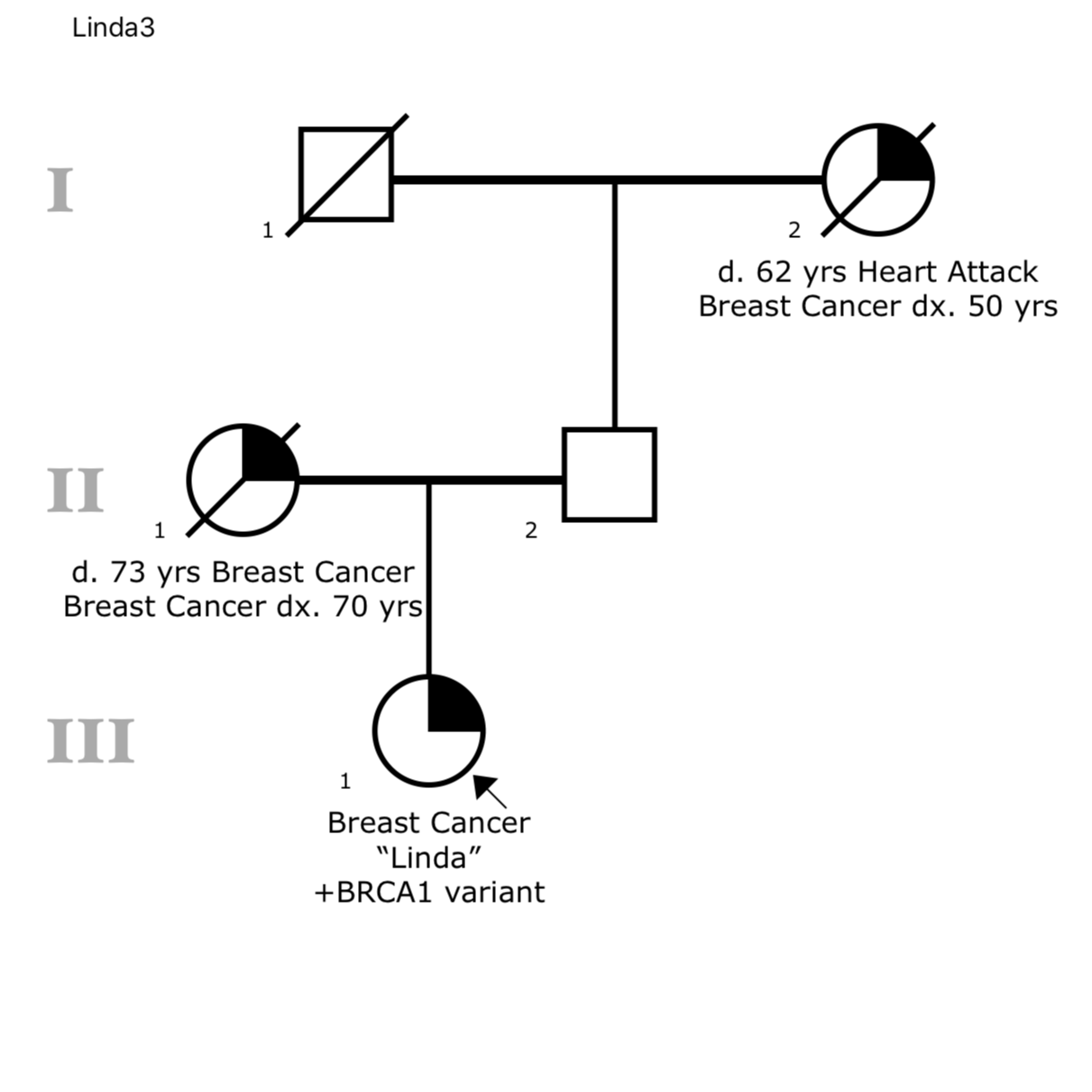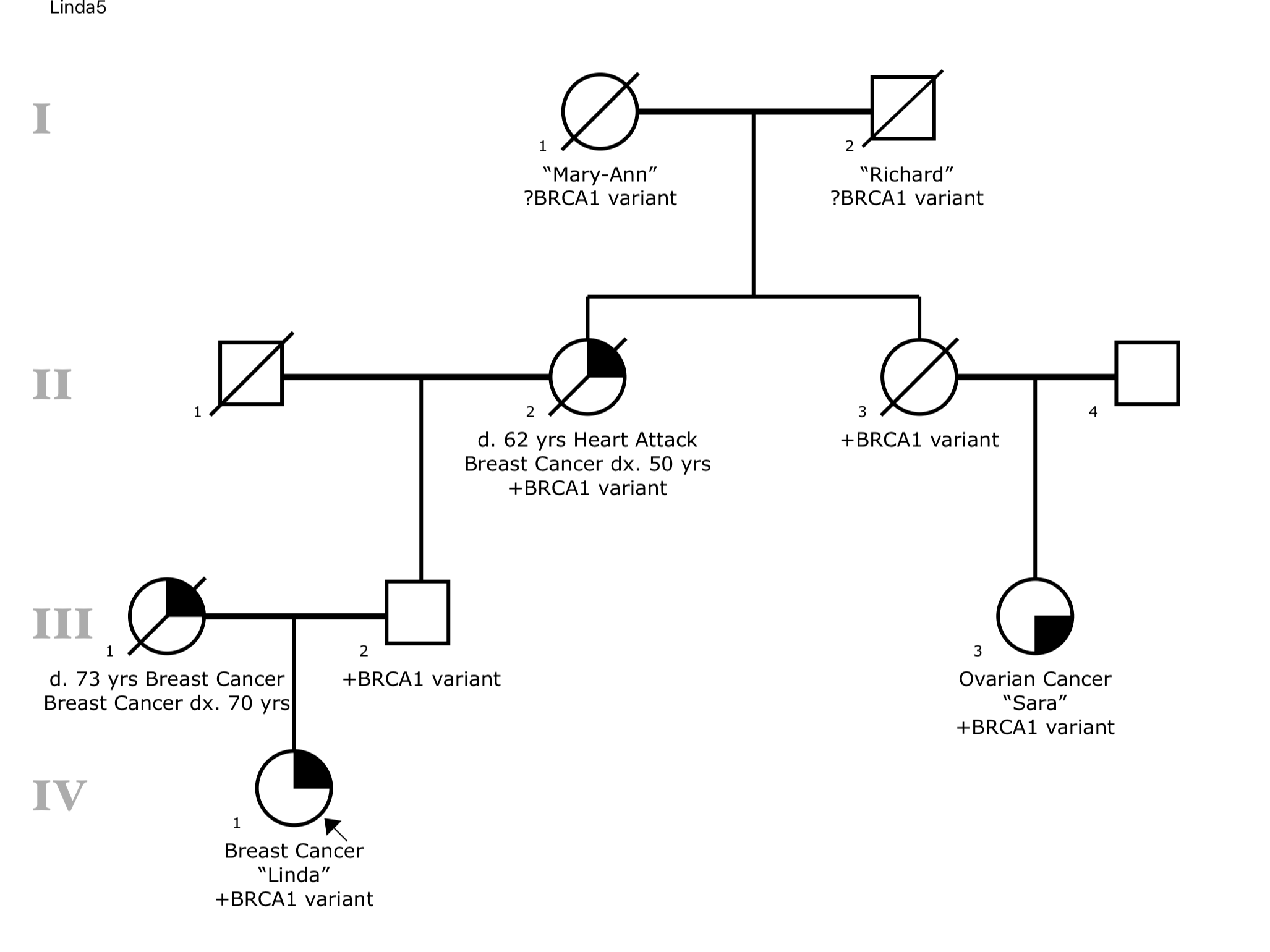Linda's Story
After being diagnosed with breast cancer, Linda did genetic testing and was told that she had a pathogenic mutation in the BRCA1 gene. When Linda was told that she had inherited the variant from one of her parents, she suspected it was from her late mother, who had been diagnosed with breast cancer in her 70’s. Linda decided that she wanted to try to trace back where she had gotten the mutation from in order to see who else could have it and who could be at risk.

But when Linda asked her family members on her mother’s side of the family about any genetic testing or cancer diagnoses, there were no other family members who had been diagnosed with cancer. She thought that she had hit a dead end with asking those relatives, so she decided to try to also research her father’s side of the family, even though she was more skeptical because he was male and did not have breast cancer. When she spoke to her father about it, he told her that he thought his mother had been treated for early breast cancer in her 50s. Linda’s father did not know much about it because he had moved away by that time, and his mother was very private about her health. Linda knew that her grandmother had died of a heart attack in her 60s, but did not know about the breast cancer story.
When Linda asked her father about any other cancer diagnoses in his family, he told her that his first cousin, Sara, was recently diagnosed with ovarian cancer. Linda was able to get in touch with Sara with help from her dad. Linda had recently had genetic testing because of her ovarian cancer. When Linda and Sara compared results, they found that they both had the same variant in BRCA1, meaning that Linda had inherited her mutation from her father.

Sara must have inherited it from her mother, who was related to Linda’s paternal grandmother. Linda and Sara started to go through their family trees to find out which relatives they had in common. They were linked through Sara’s maternal grandparents and Linda’s paternal great-grandparents, Richard and Mary-Ann. One of those two had the variant, but they could not tell which one.
Linda decided that she wanted to look for more distant relatives who had her variant. She found Connect.MyVariant. Based on the information, she decided to create a forum for her variant on the American Cancer Society’s Cancer Survivor network. She added this forum to the Connect.MyVariant forum list. She also emailed the Connect.MyVariant team and they told her how to find the genomic location of her variant (chr17).
Linda told Sara that she was looking into finding more distant relatives who might have their variant. She said that she was thinking doing a commercial DNA test, in order to help her find out more about who she might be distantly related to, which could help her investigation. Sara encouraged Linda to the Ancestry DNA test because she herself had done it a few years ago, out of curiosity, as part of her family history hobby. Sara had found out about many of her genetic relatives, and she wanted to see how much Linda was connected through their DNA. Linda and Sara immediately connected their family history trees on the Ancestry website, because they already knew about their connection through Mary-Ann and Richard.
Linda kept on browsing the ConnecyMyVariant website, and she saw that you could find more genetic relatives with DNA. After Linda sent the DNA saliva kit back and received an email about her results, she could see that she and Sarah were indeed related, and shared 318 cM across 18 segments of DNA. Linda wanted to see which DNA segments she shared with Sara. She knew that she shared the segment on chromosome 17 with Sara, because that is where she had learned BRCA1 is. Linda wanted to see if she could find anyone else that shared the same segment of chromosome 17 DNA. Even though the Ancestry DNA testing results provided a list of shared matches between Sara and Linda, they did not provide enough information to figure out who shared that specific segment on chromosome 17. To figure this Linda went to GEDmatch.com. Linda downloaded her raw DNA information from the DNA ancestry testing company website and uploaded it to GEDmatch. She also asked Sara for permission to put Sara’s DNA results on GEDmatch too, since she wanted to find out who had the same chromosome 17 segment as both of them. Sara agreed, and Linda uploaded both of their DNA results onto GEDmatch.
Linda used the “Matching Segment Search” tool to find relatives that shared the same segment on chromosome 17 where BRCA1 was with her. She found 4 people who did. One of them was Sara. She knew that about half of these people would have the BRCA1 copy she inherited from her mother, but she knew that she wanted to find the people with the BRCA1 copy with the pathogenic variant, which she inherited from her father. Since Sara also had this BRCA1 copy, Linda did the “Matching Segment Search” using Sara’s GEDmatch number. She saw 6 people, including herself, who shared the chromosome 17 segment with Sara.
In the end, Linda found 2 distant relatives that she did not know about before who shared chromosome 17 segments with both her and Sara. These two people may have inherited the same genetic variant. Since these users had provided their email addresses on GEDmatch, Linda was able to contact them. These two people were siblings, Marc and Shauna, who had uploaded their data to GEDmatch after they had done 23andMe. Linda shared her story about her pathogenic variant, and also encouraged Marc and Shauna to get clinical genetic testing because they may also have inherited the same variant from a common ancestor. Marc, said that he was not interested in genetic testing at that time but would think about it in the future, especially if it might be relevant for his young daughters. Shauna said she wanted to get tested as soon as possible because she felt that her cancer risk would be high, being a woman in her 30’s. She knew that her maternal grandmother died in her late 60s of ovarian cancer, and wondered if it could have been because of BRCA1.
Shauna found a genetic counselor near where she lived and contacted her to make an appointment to discuss getting genetic testing and learn more about her risk for cancer.

